I Wrapped My House in Straw
by Cadmon Whitty
A straw bale builder turns an ugly old, energy-eating house into a cozy, efficient home with a unique straw bale retrofit process.
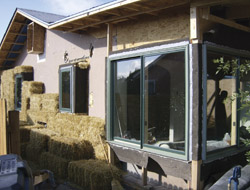 It all started ten years ago on San Rafael Avenue. It all started ten years ago on San Rafael Avenue.
The divorce has put me into a tiny apartment where I’ve lived for almost half a year with my two small children until we just can’t stand being so cramped; anything and any place will be better than this, we say. Just around the corner, on San Rafael Avenue, is an aged two-storey house that has sat uninhabited for almost a year with a For Sale sign, cracked windows, dying grass, peeling stucco and ugly paint…but, when I inquire about it, I discover it fits my tiny-affordability price range and at 1,800 square feet certainly is bigger than the apartment. So we do it. I sign the paperwork, clear out the worst of the dusty carpets and we move in.
I’ll never forget that first night in the house. My two sons go to sleep early, so I prowl through the place and compile my to-do list…then I sit alone in the living room wondering: So how exactly does one deal with an old house? What to do with essentially no insulation in the walls and windows that leak badly? How about the sag in the roof and no insulation up there either? What should I do with the local gas company’s records sitting here in front of me that show it cost hundreds of dollars each month last winter to heat and hundreds more dollars per month this past summer to cool? And then there’s need for a completely new grid of electrical wiring throughout the place, which will mean tearing out all the sheetrock to put the new wires in, then patching everything! And how to do it all with so little money available?
My mind turns back in time. I founded a company eight years earlier that specializes in straw bale construction and by now I’ve built dozens of both houses and walls using bales. The advantages are well-known to me: I’ve made uniquely-beautiful privacy walls out of it and my old 2,400 square foot bale home (now lost to the divorce) had monthly winter heating bills as low as twenty dollars – and no need for cooling in the summer. I am wildly enthusiastic about straw’s potential. But more importantly, I realize, the process of practically inventing a new building method is forcing me to think differently, very differently, about this whole concept of construction. 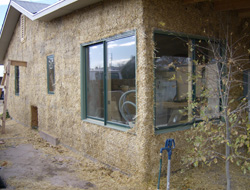
On that first night, sitting quietly in my newly-acquired old house and confronted with a long list of seeming impossibilities, I promise myself I’m going to use straw to make this house – this house which no one but crazy me seems to want to buy – into a thing of beauty. And more energy-efficient. And more valuable. And, I also promise, I’m going to think completely differently about how to do it.
The walls desperately need insulating and the stucco needs repairing. Putting straw bales against the walls should solve both problems – and although I don’t yet know how, I’ll somehow figure that part out. But first, I ponder the idea of rewiring the house from the outside. That means I won’t have to tear out all interior sheetrock and then patch it, but instead I can just punch through the walls wherever I want an outlet or switch – and then I’ll cover the wires with bales! We go to work, an electrician-friend and I, and are amazed how easy it is: no drilling through countless two-by-fours to impede our progress, no dusty wall cavities to set us coughing; we just run the wires outside the house and put as many plugs inside as we want. The job is accomplished in a couple weekends at a fraction of the cost it would otherwise have been.
Next is the body of the work: bales. Here, I’m at a bit more of an advantage because I’ve worked with straw and I’ve put up privacy walls that are maybe eight feet tall. But in this case, I’m looking at a two-storey house and immediately I’m facing unknown questions. Will twenty feet of bales stacked on top of each other just crush the bottom bales? What happens when I come to window openings, especially window openings I want to make bigger or smaller; how on earth to keep those stable? And how to attach them to the existing structure so the whole thing won’t peel off in some windstorm? I nervously pour a footing around the perimeter and cautiously begin stacking.
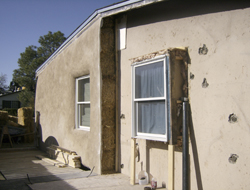 But I needn’t have worried. I cut small holes through the old stucco to find the house studs, attach baling wires to those studs and am delighted how solid each bale becomes as I cinch them several times to the studs, then jump on them to test my system. It still stays solid. Even after I’ve gone up as high as I’ve ever done with free-standing privacy walls – eight feet – the bales are completely stable, allowing me to create wood rough openings around the windows and rest them on those bales. More jumping and pushing occurs; I continue to be delighted at the stability but I am wondering what my neighbors must be thinking as they watch this strange man putting straw, of all things, around his house, then seemingly trying to pull, push or force those very bales off the walls! But I needn’t have worried. I cut small holes through the old stucco to find the house studs, attach baling wires to those studs and am delighted how solid each bale becomes as I cinch them several times to the studs, then jump on them to test my system. It still stays solid. Even after I’ve gone up as high as I’ve ever done with free-standing privacy walls – eight feet – the bales are completely stable, allowing me to create wood rough openings around the windows and rest them on those bales. More jumping and pushing occurs; I continue to be delighted at the stability but I am wondering what my neighbors must be thinking as they watch this strange man putting straw, of all things, around his house, then seemingly trying to pull, push or force those very bales off the walls!
Now I’m up at the roof line placing the final row of straw under the eaves, which, thankfully, are just wide enough to accommodate a bale’s width, and I stuff bucket after bucket of loose straw up into the overhang then clamber back down the scaffolding and examine my handiwork. I’m out of time and out of money so the project will have to sit through the winter – New Mexico’s dry climate will allow this without harming the exposed bales – but already the house is looking and feeling better.
Through the cold months, my sons and I make a bit of a game out of each gas bill: When one arrives in the mail we eagerly tear it open to see if my work has paid off, then as the evidence mounts that it’s costing about half of what it used to in order to heat the place, we use that as an excuse to go down to the local Cold Stone Creamery and celebrate. Cold Stone gets a number of months’ worth of steady business from us. But I’m eager for spring, for more money, for the chance to continue my experiments and I spend endless hours dreaming about how to attach stucco netting, how to replace the windows – if I can afford new ones, that is – and nervously brooding over how to pit the puny strength of my arms and shoulders against the huge job of applying stucco to all that bale-work.
Spring (and early summer) arrive and slowly the necessary materials are gathered. I begin attaching stucco netting but face another unknown: How exactly to do it? When building houses and walls, I have access to both sides of the bales and can simply sew the netting by pushing big two-foot needles threaded with baling wire through one side of the straw and back again. Here, though, I only have one surface available because the other side is attached to the wall of my house. I’ve got securely-fixed bales, but how to make sure the netting is equally secure? I grab a hammer and try making a C-shaped needle which I push into and then out of, the bales from the one available side, but it’s very awkward and the result is not too stable. I go to the store and buy hundreds of zip-ties and use the strings on the bales as attachment points. 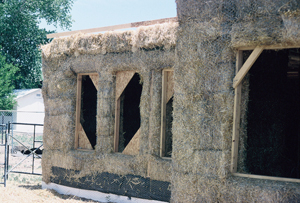
This is better; the netting is fairly sturdy but there are still numerous loose areas. Then I remember the first straw bale workshop I went to and I recall our venerable leader, ol’ Steve Macdonald himself, holding up a large piece of wire bent in a U shape and asking us what it’s called. It’s a U-shaped-wire! I wisecrack. No, no, says Steve, it’s a Robert pin. Why Robert? asks another man. Because, replies Steve with a smile stealing over his face, it’s too big to be a Bobby pin. At the time, we groaned and hissed and shook our heads, but now I’m beginning to see what Steve was getting at. I buy the thickest wire I can find, make some Robert pins, push those pins into the straw wherever the netting is loose, and – mirabile visu! – the netting becomes sufficiently tight.
I’ve managed to gather an assortment of new windows. Most of them are the right size for their openings and can simply be attached to the two-by-four wooden frame I’ve put into the bales, but a few of the second-hand windows are too big for their frames. I know from “conventional” straw bale experience that one can usually just carve bales to allow for any additional size – but here at my house, I’ve got rows and rows of bales above some of the windows. What to do now? I cannot just cut the original window buck out, can I, without all upper straw sagging? Cautiously, I climb back onto the scaffolding and start the chain saw. My son is watching me through the original single-paned window from the inside. He hears the chain saw start up, sees straw flying everywhere as I make the window opening bigger; through the closed window he hears me whooping as I slide the old window buck out…and the bales above don’t move.
The system of attaching the bales to the house frame and the netting to the bales works even better than I’d hoped! My son gives me a thumbs-up from inside, a new window frame is quickly placed in the widened opening, straw is stuffed in loose areas, the netting is reattached and the window goes into the now perfectly-sized frame. I can remove the old window, which is now on the inside of the wall, apply curved pieces of wood or sheetrock to the space between my new window and where the old one was and paint it to match the newly-painted interior walls.
More time passes. It’s frustrating, as well as exhilarating, to be living in a construction zone, only to move the project forward when I have the right combination of time and money. I discover that during the regular construction season I have money available but little extra time – and when my “real” job slows, I have lots of time but no money. Luckily, except for the stucco work, I’m approaching the end of the job and what’s left to be done is much more conventional. I rent an insulation-blower and stuff the tiny attic full of recycled newspaper-choppings. I irritate my friends no end by cheerfully telling them almost every weekend that “hey, there’s a stucco party on San Rafael” and, bit by bit, the hard, hard work of hauling endless buckets of wet stucco up the scaffolding and plastering it onto the bales is accomplished. Once that’s happened – by now it’s fall again – I hire a company to apply the color coat…and exhaustedly stand back to view the finished product, and begin an analysis of what I’ve done and how I did it.
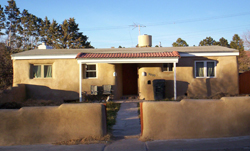 |
The advantages of having wrapped my home are clear. My monthly gas bills have fallen to an incredible one-quarter of what they originally were and the electricity used is maybe half of what it was. The house has been transformed into a thing of beauty with the thick walls and wide window-wells that are such an attractive hallmark of any bale house. It’s quieter inside. The revamped electrical system works well, the new stucco glows, the windows open and close and are not cracked, as many of the old ones were. And my skeptical and long-suffering neighbors, who endured two years’ worth of blowing straw and piles of sand on the sidewalk, are pleased that their own property values have gone up with the improvement of my house. Best of all, maybe, I’ve proven to myself that use of straw bales for a retrofit really does work – and that it’s a low-tech method, which any reasonably able-bodied person could do to their own house. I begin making plans to incorporate retrofitting old homes as part of what my construction company offers.
But everything is not peachy; sticky problems remain and I review those challenges, too. Albuquerque’s permitting office has generously allowed me to perform my project as an owner-builder, but what will happen if others do so as well? My home is wood frame, but would the same concepts work on a concrete block house? The overhangs on my roof were wide enough to allow me to stuff the straw under them, but will I need to extend other roofs in order to do the same – and will that then put additional pressure on the trusses? Then there is the problem of doors and windows: I have been able to replace the existing ones on my home but it proved quite difficult to change those window sizes; is there a way to place new window openings in a dark room without compromising the structural integrity of the house? In the two years it took me to completely finish the project, several families of mice began cohabitating with me and I occasionally hear them rustling through the straw; I’ll need to find ways to completely insect- and rodent-proof the place. And although, of course, a foundation to keep the bales above ground level is necessary, and although I have covered the foundation with rigid insulation, the comparatively-poor insulation of the concrete compared to the R-45 value of the bales has created something of a thermal break around the house’s perimeter, which, on cold winter mornings, sends a small stream of palpably chilly temperature into the basement. There is certainly no shortage of challenges in inventing this alternative system – and in thinking differently about the larger concepts of turning old houses energy-efficient!
People contact me regarding my “experiment.” I begin retrofitting other homes, working with both the homeowners and with my construction crew. The latter has been meticulously trained to critique my work and tell me better ways of doing things: The standard joke around Paja Construction goes something like, oh so you’ve finished stacking up them bales, eh? Great! Now, how could we have done it differently? Under my co-worker’s careful tutelage, we work on modifying the foundation design, the window openings design, methods of attaching netting, etc. We do extend the roof overhangs and discover that it works well; we retrofit concrete blocks and make that work; we ensure that neither insects nor mice can enter the bales. We even apply the retrofit concept to mobile homes and to a pre-manufactured house – and are quite impressed. In between such work, I come home every afternoon to my own original experiment and continue examining it for what could happen over the years to a retrofit. I resolve the mice issue. I watch to see if the bales will eventually settle and thus crack the stucco (they don’t). When Steve Thomas, the producer of the popular TV show This Old House, contacts me for some video shoots, I cut a section of the stucco off to allow the camera’s focus on how I had done the retrofit…and I find the bales in as pristine condition as on the day nine years ago when I stacked them.
These days, with heating/cooling prices soaring and home values falling, I’ll not infrequently look around my place with a kind of wonderment: Is this cozy place really that falling-apart house I tentatively bought a decade ago? Time is marching along. My two small sons are tall teenagers now, the tiny cottonwood tree that we planted shortly after moving in is now taller than the building and wide-leafed thanks to the grey-water system, which allows it to lap up whatever water it needs. The gas and electric bills remain as low as ever, the revamped fireplace supplements the living room heat in winter, the wood floors that had lain hidden for years under old carpets are now glowing with natural colors. What more could I ask of a house that has truly turned into a home?
Although the majority of author Cadmon Whitty’s work is in the southwestern U.S. – he lives in Albuquerque New Mexico – he was born in South America and spent the first two decades of his life in Paraguay, in England and on the U.S. East Coast. He joined a construction crew in 1980 and learned conventional methods, but soon became interested in alternative building, which can be more environmentally-friendly and often much less expensive. He spent time in several developing countries working with such alternatives and in the early 1990s relocated to New Mexico to continue the process. He is a founding member of the New Mexico Straw Bale Construction Association, participated in the initial laboratory experiments that tested the structural abilities of straw, formed Paja Construction, Inc. (‘paja’ meaning straw in Spanish), pioneered a variety of methods for building with straw and began leading quarterly workshops. In addition to having built over sixty houses and hundreds of walls, Cadmon has given workshops on straw projects across the U.S. and in Mexico and Canada. For comments on this article or questions about straw bale construction, he can be reached at 505-306-2529, by email at cadmonwhit@aol.com or via his website www.pajaconstruction.com.
|

